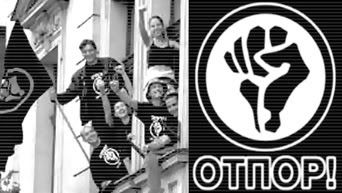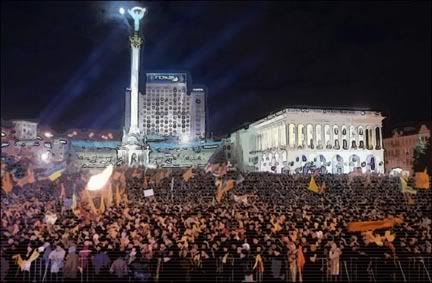Adam Larson / Caustic Logic
Guerillas Without Guns / Chapter 2
Posted June 24 2007
As Milosevic’s tottering regime came up against the “NATO foot soldiers” of Otpor in 2000, the group and its allies also looked ahead and worked to co-opt as much of the security forces as possible. For example, the young members of Otpor sent bouquets of flowers to the military on Army Day. An article in Peace explained that “such tactics recruited sympathizers in numbers that would not be apparent until the final days of the regime, when soldiers and police stood by while massive crowds stormed the Serbian parliament.” [1]
As the September 2000 election neared, the Serbian president banned international observers from monitoring elections, which were carried out on Sunday the 24th. The opposition claimed victory, with DOS leader Vojislav Kostunica winning over 50 percent support and declaring himself the “people's president.” But others were not so sure, and the Federal Election Commission called for a second ballot set for October 8, saying neither candidate won an outright majority. [2] Another top DOS leader, Zoran Djindjic announced “we will call people onto the streets and tell them not to leave until [Milosevic] gives up power.” [3] Djindjic said the opposition would call for continued protests, including a strike campaign and boycotts of schools, offices, theaters and cinemas. [4]
By this time, Milosevic’s Red Berets had evolved into an independent, self-perpetuating power, and when the regime began to crumble in mid-2000, they switched sides and negotiated a nonaggression pact with Djindjic, assuring him that they would refuse any orders to crack down on demonstrators. [5] With this floodgate opened, a coal miners' strike set the ball rolling; when Milosevic sent Interior Ministry soldiers to break the strike, thousands more citizens turned out in solidarity, blocking streets with barricades and their bodies. [6]
 Mass protests in front of the Parliament building, Belgrade, Oct. 5 2000.
Mass protests in front of the Parliament building, Belgrade, Oct. 5 2000. The strikes spread and by the 5th the country had come to a virtual standstill, except in the capital, where crowds swelling into perhaps hundreds of thousands of opposition supporters marched and swarmed around, over, and into all the official buildings. The central square was hazed with smoke from fires started by the protesters, lending to the air of chaos as police simply refused to crack down and the insurgents took the whole area, notably the State-run broadcasting apparatus. [7] Kostunica told supporters at a Belgrade rally that Serbia had been “liberated,” a message broadcast to the world. European and world leaders called for Milosevic to admit the obvious and step down as he finally did the following day. [8]
Otpor’s Ivan Marovich proudly boasted that Otpor and the people of Serbia had thus “organized the control of the elections by the civil society.” [9] When that alone proved insufficient, with Milosevic declaring victory anyway, they also helped organize the control of Belgrade, which finally did the trick. The actions of Otpor could not be credited entirely with the results, but they were by all accounts a huge, probably decisive factor in this bloodless revolution that achieved what NATO’s bombs had not. And their spirit of fun was infectious, leaving its mark on the October 5 uprising, dubbed “the Bulldozer Revolution.” It got this unofficial title when a man inspired by Otpor’s lead drove his bulldozer into the building of RTS, Serbian state television, which had been a symbol of Milosevic's rule. (this was a new building, the original having been recently destroyed by NATO bombs).
In the months following, Otpor members were the cause celebré of Serbia and the world at large and their clenched fist logo started popping up everywhere. Especially in Europe, politicians, rock stars, soccer teams and more brandished it proudly. Representatives of the group were even handed a special “Free Your Mind” award at the November 2000 MTV Europe Music Video Awards in Stockholm. MTV Europe’s CEO praised the youngsters’ “constant struggle against injustice and oppression.” [10] Americans in general were faintly pleased but basically unaware of the entire episode. Serbs were by and large elated. It had all seemed so easy once they figured it out – “break the fear,” follow the lead of the superbly-trained and confident young activists, take a clever, flawlessly printed sign and join the thousands of others doing the same. Like a powerful drug secretly administered in their sleep, the whole episode was liberating and exhilarating, almost too good to be true.
Sources:
[1] From Peace Magazine Apr-Jun 2003, p.10. Author=John Bacher; Title=Robert Helvey's Expert Political Defiance; URL=http://www.peacemagazine.org/archive/v19n2p10.htm
Robert Helvey's Expert Political Defiance
John Bacher
[2], [3], [4] Fletcher, Philippa. “Opposition Pressures Milosevic To Resign.” Reuters. St. Petersburg Times (Russia). Issue #607 (0), Friday, September 29, 2000.
http://www.sptimes.ru/index.php?action_id=2&story_id=12704
[5] Aaron, Paul. “The Anguish of Nation Building: A Report from Serbia.” World Policy Journal. Volume XXII, No 3, Fall 2005.
http://worldpolicy.org/journal/articles/wpj05-3/aaron.html
[6], [7], [8] A Force more Powerful: Films: Bringing Down a Dictator: Chronology of Events.
http://www.aforcemorepowerful.org/films/bdd/story/chronology.php
[9] Htet, U Min. “Serbia: Demise of a Dictator.” BBC News. September 16 2005.
http://www.bbc.co.uk/burmese/learning/story/2005/09/050912_transition_prog12.shtml
[10] BBC News. “Madonna's MTV triumph.” November 17, 2000.
http://news.bbc.co.uk/1/hi/entertainment/1027299.stm


